01. Which option should an administrator choose if they need to run Cloud Pak for Integration (CP4I) on AWS but do not want to have to manage the OpenShift layer themselves?
a) Deploy CP4I onto AWS ROSA.
b) Use Installer-provisioned-Infrastructure to deploy OCP and CP4I onto EC2.
c) Use the “CP4I Quick Start on AWS” to deploy.
d) Using the Terraform scripts for provisioning CP4I and OpenShift which are available on IBM's Github.
02. What is the function of Elasticsearch in the Cloud Pak for Integration logging service?
a) Index, search, and store log data.
b) Capture, collect, and forward log data.
c) Query, discover, and visualize log data.
d) Collate, correlate, and interpret log data.
03. Cloud Pak for Integration has just been installed on an OpenShift cluster. How can the Cloud Pak for Integration administrator password be obtained initially?
a) Log in to the OpenShift web console as the "cluster-administrator" and access the platform-auth-idp-credentials secret in the openshift-cp4i project.
b) Log in to the OpenShift web console as the "cluster-administrator" and access the platform-auth-idp-credentials secret in the ibmcommonservices project.
c) Log in to the cluster as a "developer" user using the CLI tool, and execute the following command oc extract secret/platform-auth-idp-credentials -n openshift-cp4i --to=-
d) Log in to the cluster as a "developer" user using the CLI tool and execute the following command oc extract secret/platform-auth-idp-credentials -n openshift-operators --to=-
04. What are two CLI prerequisites to administer OpenShift Pipelines?
a) oc
b) tkn
c) git
d) docker
e) podman
05. When creating a quick start queue manager from the Platform Navigator in Cloud Pak for Integration, which statement is true if the default configuration is used?
a) A multi-instance queue manager will be created.
b) Persistent storage will be allocated for storing messages.
c) Messages will not be persisted across restarts of the queue manager pod.
d) Security is configured to only allow users in the mqm group access to queues.
06. What are two ways to track license usage in a multi-cluster environment?
a) Using License Service Reporter.
b) Install Multi-cluster License Service operator.
c) Manual procedure for creating consolidated reports.
d) Using command-line interface for generating merged reports.
e) Invoking License Service API for multi-cluster bundled report.
07. Which is a capability of the Operations Dashboard?
a) Resource scheduling.
b) Application Security management.
c) Managing Integration configuration.
d) Cross-component transaction tracing.
08. Which statement is true about the installation of Process Mining onto an existing Cloud Pak for Integration (CP4I) Cluster?
a) Process Mining only works with air-gapped Cloud Pak clusters.
b) Process Mining must be installed into the primary “cp4i” namespace where the platform navigator resides.
c) Process Mining can be installed multiple times in different namespaces on the same cluster.
d) Process Mining is only useful when other Cloud Paks outside of the Cloud Pak for Integration are being used together.
09. How can an administrator manage additional namespaces, if the Platform Navigator is installed into 'All namespaces'?
a) By assigning them to a team.
b) By assigning them to a user.
c) By assigning them to a group.
d) By assigning them to a new node.
10. When using Confluent in a Cloud Pak for Integration cluster, what is the impact if the Kafka Data is lost in ZooKeeper?
a) No impact, Confluent does not utilize ZooKeeper.
b) No impact, ZooKeeper is automatically resilient to data loss.
c) Mapping of replicas to Brokers are persisted to disc and auto recovered.
d) Mapping of replicas to Brokers and topic configurations would be lost.
 The purpose of this Sample Question Set is to provide you with information about the IBM Cloud Pak for Integration V2021.2 Administration exam. These sample questions will make you very familiar with both the type and the difficulty level of the questions on the C1000-130 certification test. To get familiar with real exam environment, we suggest you try our Sample IBM Cloud Pak for Integration Administration Certification Practice Exam. This sample practice exam gives you the feeling of reality and is a clue to the questions asked in the actual IBM Certified Administrator - Cloud Pak for Integration V2021.2 certification exam.
The purpose of this Sample Question Set is to provide you with information about the IBM Cloud Pak for Integration V2021.2 Administration exam. These sample questions will make you very familiar with both the type and the difficulty level of the questions on the C1000-130 certification test. To get familiar with real exam environment, we suggest you try our Sample IBM Cloud Pak for Integration Administration Certification Practice Exam. This sample practice exam gives you the feeling of reality and is a clue to the questions asked in the actual IBM Certified Administrator - Cloud Pak for Integration V2021.2 certification exam.